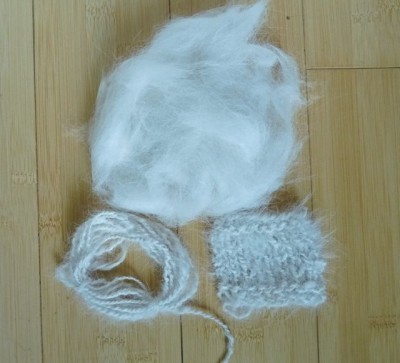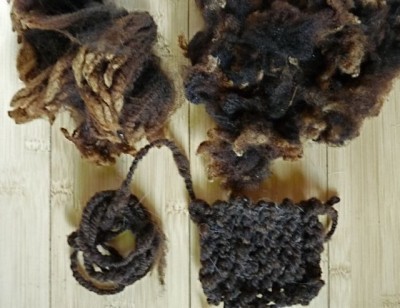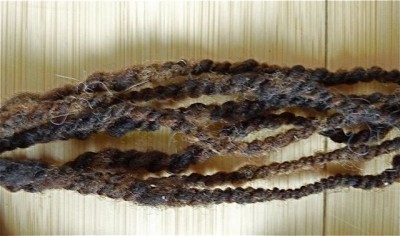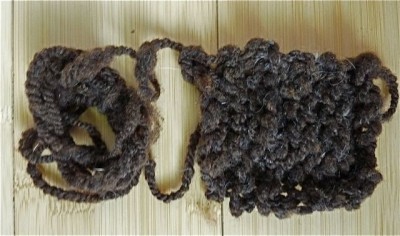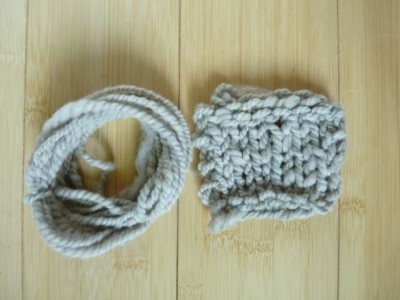Mandy Moore's Blog, page 113
June 8, 2011
WWW: Contest Winner, Superheroes & Interesting Places to Knit
The winner of our LoopDLoop book and yarn giveaway is Sue from Chicago. Congrats, Sue, & happy knitting!

Yarn monster hungry for yarn!
Another excellent knitting-related Kickstarter campaign is underway… the Yarn Monster is the cutest, coolest, must amusing ball-winder you have ever seen, I can guarantee you.
Not just adorable, the Yarn Monster is a fully functional electric ball winder, with remote control, variable speeds and direction reverse.
Even if you're not a looking to invest, go watch the video.
It was invented, as you might expect, when an imaginative developer was pressed into helping his girlfriend wind yarn. One imagines it was a skein of laceweight, something that gave him enough time to cook up such a great idea.
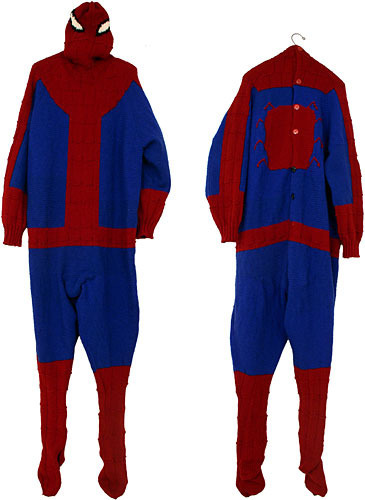
Yarny-man
The Jackson Hole, Wyoming Weekly paper has a great interview with fiber artist Mark Newport. The mission of the artist-in-residence and the head of the fiber department at the Cranbrook Academy of Art in Bloomfield, Michigan, is to explore our understanding of masculinity and gender roles. He knits superhero costumes out of acrylic yarn, playing with our expectations about sturdiness and protection.
His most recent show, Sweatermen, expands to include the quintessential American superhero, the cowboy.
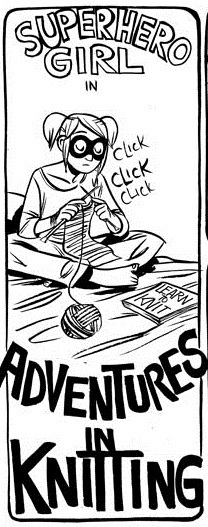
Knitting is a superpower!
On her blog, cartoonist Faith Erin Hicks published an installment of her comic strip "superherogirl", documenting her frustrations with knitting. If any readers live in Halifax, NS, perhaps you can arrange to give her some lessons and support….
More WWKIP day events have been added the listings on the site.
Every Tuesday, 1:30-3pm, all through the summer, Bryant Park in New York City is hosting free outdoor knitting lessons. More details. Take a non-knitting friend and an iced coffee and enjoy the fresh air!
The New York Times recently had a really great feature about the history of and key figures in yarn bombing. Our own Mandy gets a shout-out. The slide show is great, and the amazing video of crochet artist Olek's wrapping of the Wall Street Bull from last year is there, too.
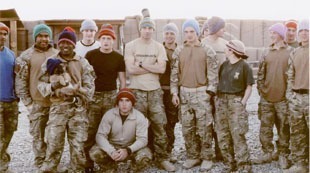
Supporting the troops with warmth.
A knitter in Wales has collected 2,300 hats to donate to Welsh troops serving in Afghanistan. She started the campaign last October, and knitters from all around the world have been contributing, and there are enough hats now for even the regiment's dog to have one.
Looking for a summer vacation with a difference? Annie Modesitt has just announced her latest teaching engagement: a trip to Iceland, for knitting classes with Annie, and to enjoy the Reykjavík Marathon and Culture Night.

WWW: Contest Winner, Superheros & Interesting Places to Knit
The winner of our LoopDLoop book and yarn giveaway is Sue from Chicago. Congrats, Sue, & happy knitting!

Yarn monster hungry for yarn!
Another excellent knitting-related Kickstarter campaign is underway… the Yarn Monster is the cutest, coolest, must amusing ball-winder you have ever seen, I can guarantee you.
Not just adorable, the Yarn Monster is a fully functional electric ball winder, with remote control, variable speeds and direction reverse.
Even if you're not a looking to invest, go watch the video.
It was invented, as you might expect, when an imaginative developer was pressed into helping his girlfriend wind yarn. One imagines it was a skein of laceweight, something that gave him enough time to cook up such a great idea.

Yarny-man
The Jackson Hole, Wyoming Weekly paper has a great interview with fiber artist Mark Newport. The mission of the artist-in-residence and the head of the fiber department at the Cranbrook Academy of Art in Bloomfield, Michigan, is to explore our understanding of masculinity and gender roles. He knits superhero costumes out of acrylic yarn, playing with our expectations about sturdiness and protection.
His most recent show, Sweatermen, expands to include the quintessential American superhero, the cowboy.

Knitting is a superpower!
On her blog, cartoonist Faith Erin Hicks published an installment of her comic book "superherogirl", documenting her frustrations with knitting. If any readers live in Halifax, NS, perhaps you can arrange to give her some lessons and support….
More WWKIP day events have been added the listings on the site.
Every Tuesday, 1:30-3pm, all through the summer, Bryant Park in New York City is hosting free outdoor knitting lessons. More details. Take a non-knitting friend and an iced coffee and enjoy the fresh air!
The New York Times recently had a really great feature about the history of and key figures in yarn bombing. Our own Mandy gets a shout-out. The slide show is great, and the amazing video of crochet artist Olek's wrapping of the Wall Street Bull from last year is there, too.

Supporting the troops with warmth.
A knitter in Wales has collected 2,300 hats to donate to Welsh troops serving in Afghanistan. She started the campaign last October, and knitters from all around the world have been contributing, and there are enough hats now for even the regiment's dog to have one.
Looking for a summer vacation with a difference? Annie Modesitt has just announced her latest teaching engagement: a trip to Iceland, for knitting classes with Annie, and to enjoy the Reykjavík Marathon and Culture Night.

June 7, 2011
Spinning Tuesdays: Cashmere for my Birthday!
My birthday is this week (June 10, 48) and to start my party week I spun cashmere from Deb Robson's Must Spin list.
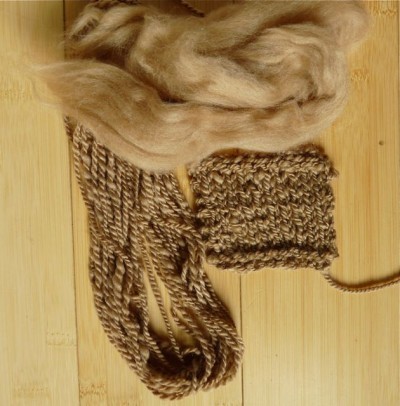
Cashmere fluff, yarn and a knitted swatch
Wow, just wow! I loved spinning this. I was intimidated at first, but I did some research and watched the cashmere part of Judith MacKenzie's Luxury Fibers DVD set. The key is enough twist for short fiber, but not as much as slippery short fiber twist. The cashmere clings quite nicely to itself, and the top preparation helps by organizing the fibers and culling the super short fibers for you.
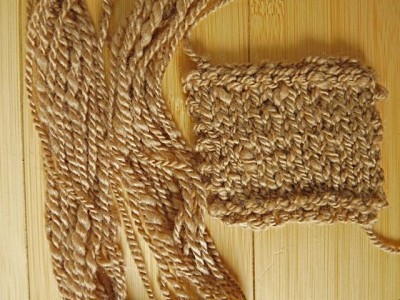
Fluffy cashmere yarn, light as a feather
I spun supported long draw and the yarn and swatch were soft and so light. Yes, I could cover my entire body in cashmere and be happy.
Two fun facts about Cashmere from The Fleece and Fiber Sourcebook:
Cashmere is not a type of goat but the downy undercoat that most goats produce.
How short is short? Staple length ranges in the 1.25-1.75 inch range.
Birthday Giveaway
In honor of my birthday week, I have a gift pack for one of you lucky spinners!
 Fabulous fiber book!
Fabulous fiber book! A copy of Deb Robson's new book, The Fleece and Fiber Sourcebook, retail $35. Thank you to Storey Publishing for the donation.
 38 rare and endangered sheep
38 rare and endangered sheep
A copy of Deb Robson's DVD set, Handspinning Rare Wools, retail $34.95. Thank you to Interweave Press for the donation.
 Spinning Loft fiber sampler
Spinning Loft fiber sampler And a raw fiber, Fleece and Fiber Soucebook sampler from The Spinning Loft, similar to the one I'm spinning over these 10 weeks. Big thanks to Beth for providing the sampler.
Retail $85
The usual rules apply. Leave a comment before midnight on Wednesday June 8,2011. A comment will be chosen at random to answer a skill testing question. If he or she answers correctly they will our prize package.

June 1, 2011
WWW: WWKIP Day Special; Contest!
Let's be seen!
World-wide Knit in Public day is promoted as the largest knitter-organized event in the world. It's actually thousands of individual events, taking place over the week of June 11th to 19th.
Just a sampling of the events being held…
Artists Nell Berger and Jean Hilkens are hosting an event starting at noon, June 11th, in Bryant Park, New York City.
In Kassari, Estonia, a group will meet at the Grill Lest & Lammas.
In the UK, a number of John Lewis locations will be hosting events in the Haberdashery departments, including their Oxford Street location in London.
In South Dakota, US, an event is being held at the 7 Beer & Wine Bar in Yankton.
In Savannah, Georgia, a group will meet at Forsyth Park from 10am to noon.
In Australia, a group will meet at the Sydney Customs House.
In Italy, a group will meet at the Villa Pamphili in Roma.
In Waterloo, Ontario, Shall We Knit is hosting an event with an Indigodragonfly trunk show, and blocking demos from SOAK.
In Cambridge, Ontario, the KNITcamBRIDGE team is hosting a Mad Hatter's tea party in front of city hall.
The website lists events all over the world. Check to see if there's something near you. If you're hosting an event, please do add it to the site!
Speaking of knitting in public, Hawaiian knitter Barbie Kihara spends up to 14 hours a day, 5 days a week in a local fast food restaurant in Manoa, knitting and crocheting. She will happily teach anyone who wants to learn, and creates projects for donation to a variety of local causes. She also volunteers her time at community centers and nursing homes to pass along her knowledge. "From young time I'd always wanted to learn how to knit and crochet, but it was hard without anyone to teach me," Kihara says. "Now I try to help other people so they don't have to go through the same thing. My mother always taught us to do things on our own, help each other and help other people when we can. I still try to do that."
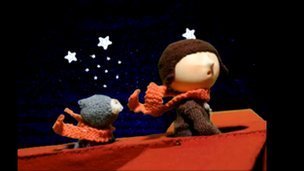
Lovely!
Charlotte Blacker, a student in the UK has won a prestigious Royal Television Society award for her knitted stop-motion film "The Little Red Plane", which she created as part of her university dissertation.
It's a genuinely lovely little movie about the adventures of a boy and his cat.
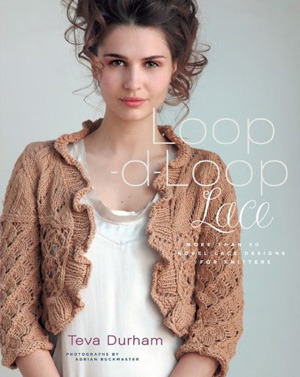
Win me!
And if you need something to knit in public that week, consider entering our contest.… we are giving away a copy of Teva Durham's brand-new book Loop-D-Loop Lace and enough Blue Sky Alpacas Worsted Cotton yarn to knit the cover sweater!
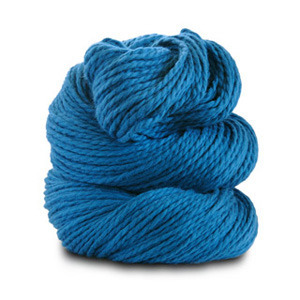
And me, too! My goodness!
1 person will win this prize, valued at $95.95, generously donated by Melanie Falick Books and Blue Sky Alpacas.
To win, leave a comment on this post before midnight eastern time, Friday night, June 3rd. Winner will be announced next week.

May 31, 2011
Spinning Tuesdays: Angora, Romeldale and CVM
I'm still spinning from Deb Robson's Must Spin list. I have learned so much about fibers I would never have spun and a whole lot about my spinning skills.
This week's spins are Angora rabbit, Romeldale and CVM.
Angora was easy to prep because there isn't any. But that's where easy stops. Angora hair is very short and slippery. I spun from a cloud of angora with lots of twist. It was hard to keep it even, and boy,oh, boy it was fly away – there was angora hair flying all over. Of all of the fibers I've spun this was the one most interesting to my little boy and my dog. So I had extra help in the form of little fingers and a big wet nose while I tried to spin.
Light and fluffy angora
I don't think I would use 100% angora for a big project, maybe a hat or a small accessory. It is hot. Even knitting my small swatch, kept my hands warm, almost sweaty. It would be wonderful blended in with other fibers for it's silky softness and halo.
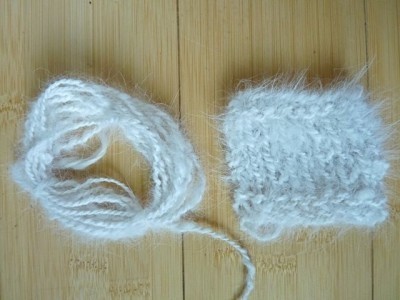
It's so fuzzy! You'll see it stuck to the Romeldale too.
Two fun facts about Angora from The Fleece and Fiber Sourcebook:
There are 5 different types of Angora rabbits that produce distinct fiber English, French, German, Giant and Satin.
Angora rabbit fiber is harvested usually every every three months.
My next spins were Romeldale and CVM
First I worked with some raw Romeldale from The Spinning Loft. I had problems with this Romeldale, but only due to my own mistakes and misjudgements. The fiber was lanolin rich and spingy. I guessed, wrong, that it would behave like a down breed and the lanolin would wash out quickly. I washed it once with Power Scour, and it really could have used another wash.
Romeldale: dirty and clean fiber, 2 ply and a knitted swatch
I decided to just flick and spin. I didn't check the staple length and it was pretty short, that plus the stickiness of the leftover lanolin made for really lumpy yarn. Not a rustic type of lumpy, but a yucky amount of lump.
I'm not a fan of this first yarn
Next I tried my hand cards. Just a quick couple of passes and I was able to control it into a yarn that I really like. This fiber has loft. Before I washed my yarn it had a WPI of 9 after I was washed it it swelled to 6. Boing!
Soft and springy, a sweater's worth please
I spun some commercially prepped CVM , top from Spirit Trail Fiberworks. Even commercially prepped the CVM still had lanolin, just the right amount.
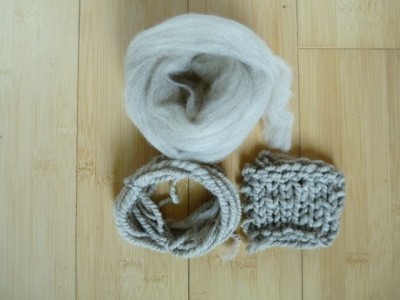
CVM: top, 2 ply and knitted swatch
That combined with the even prep of top made this an even lofty spin. This yarn swelled when set, but not nearly as much as the raw Romeldale from 10 to 9.
CVM yarn. I love the creamy gray color
I would wear both the Romeldale and CVM next to my skin. When I spin with these fibers again, and I know I will, I'll do a lot more sampling. These are fibers that, for me, need to be sampled at every step – how many washes, the prep and for yarn WPI before and after the final wash.
A fascinating breed that really tripped me up. I want to spin more of this.
Two fun facts about Romeldale/CVM from The Fleece and Fiber Sourcebook:
In a colored fleece the color can change along the staple length as well as throughout the fleece.
Their wool becomes darker and finer with age.
What are you spinning this week?
I'm feeling a need for color again; let's see what mischief I can get into by next week!

May 30, 2011
Historical Treasures: The Winchester School of Art Knitting Reference Library
 The Winchester School of Art Library at University of Southampton in the UK is the home of the rather remarkable Knitting Reference Library.
The Winchester School of Art Library at University of Southampton in the UK is the home of the rather remarkable Knitting Reference Library.
One of the library's strengths is its focus on textiles, textile art, fashion and dress history. The collections have been significantly enriched by the addition of three distinctive knitting collections acquired from renowned practitioners and scholars in the field: Richard Rutt, Jane Waller and Montse Stanley. These three knitting historians have each made a remarkable contribution to the literature with the books they have written, and to see the collections that inspired and informed them is a wonderful opportunity.
The Knitting Collections held by the University of Southampton provide a rich range of resources covering the many facets of knitting from the everyday and kitsch to the historical, technical and beautiful. The Knitting Reference Library comprises books, journals, magazines and an estimated 12,000 knitting patterns, and over 800 knitted objects, tools, photographs and postcards.
The school is also home of the In The Loop conference. The last event, in 2010, titled "Knitting origins and evolution" was held, fittingly enough in Lerwick, Shetland, and included presentations from both artist and academics on a broad range of knitting-related topics, historical, technical and sociological.
The next event is scheduled for September 2012, and the theme is "Voices in Knitting".

May 26, 2011
How to choose your first ukulele: an essay by your uke-obsessed Editor.

Hana Hou!
Well, it's the day after the big Spring+Summer Surprise went live and one of the patterns in there was not much of a surprise for anyone who follows my Twitter feed: a felted case for a ukulele or two. [Kudos to designer Wendy Bernard who turned a whimsical idea into a functional and fabulous pattern that I hope lots of you will make!]
One might wonder what took us so long to serve up something uke-ish. I admit that I was hesitant, because I try not to make Knitty only about what I love personally, but what I think our readers will love. Of course it doesn't hurt if I love it too.
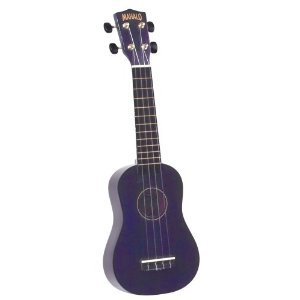
a little purple Mahalo started it all
But Jillian kept urging me to get a uke case pattern designed and in the magazine and I finally saw the wisdom in her idea. Because it's not just me that loves the uke.
Ukuleles are experiencing a resurgence not seen since the 1950s, with movies like The Mighty Uke showing to packed houses, and musicians from Train to Amanda Palmer to Eddie Vedder reclaming the little 4-stringed wonder. I've been playing the uke since 2008, when I traded a skein of yarn for a purple Mahalo. It was this video that made me want to learn how to play the uke. [aside: yes, that's Bret of Flight of the Conchords, 2nd from the left.] I have been very fortunate to find a ukulele community that meets and plays together weekly, and thanks to these sessions, I'm getting better all the time.
But what is the point of this post? It's to tell you that you can do it too. The ukulele is absolutely the friendliest, easiest instrument to learn on this planet. Easy to learn, hard to master, sure. But you can learn 3 or 4 chords, and be playing along with a group in less than an hour. And with a little practise, your repertoire of chords will grow, just like mine did. With the uke, I have found it's about enjoying music, not about being a kickass performer. It's about F.U.N.
People ask me what kind of uke to start with, so that's really the point of this post. This is my best advice for those starting out with the uke with zero experience. There's no way to know if you'll like the uke until you play one for a while. So I recommend you choose one of the colored Mahalo soprano ukes, like the purple one shown above, at a cost of around $20.
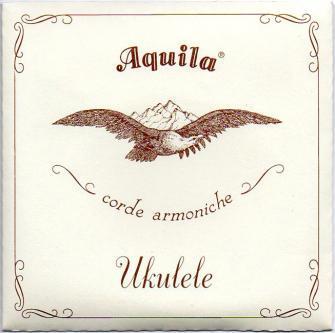 First thing, replace the crappy strings it's wearing with a set of Aquila Nylgut strings. This will make a world of difference. If you're new to stringed instruments like I was, don't be surprised that the strings don't hold their tuning for long. They're plastic and they will stretch for a while until they settle in.
First thing, replace the crappy strings it's wearing with a set of Aquila Nylgut strings. This will make a world of difference. If you're new to stringed instruments like I was, don't be surprised that the strings don't hold their tuning for long. They're plastic and they will stretch for a while until they settle in.
Next, download a chord chart, and learn some basic chords. C, F, G will get you a long way. Add A, D and E7 and you've got a lot to play with. Visit Chordie and type in some song names, and you'll find things to start playing!
I'll skip the part about playing as much as you can, because if you like the uke, you will do that. I'll also skip the part about googling and finding [hopefully] a uke group near you. If you don't find one, you can always start one, right? Think of it like a musical S&B night.
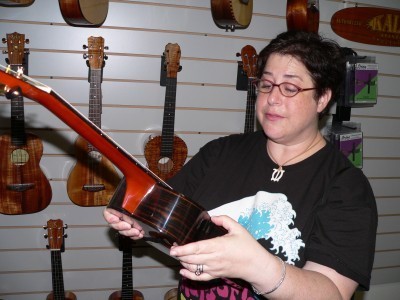
I meet my Pono Tenor at the now-closed Music Guy Mic's...and fall in love at first sight.
You love the uke and are ready to upgrade? The next place to start looking is the $100-300 range. You can go up into thousands of dollars with ukes, but to get something really playable for a relative novice, you don't need to spend more than $300ish.
Brands I recommend are Kala, Ohana, Pono. Kala is most affordable and has some fun models, if aesthetics are your thing [I like this plaid model]. Ohana is a factory-made uke with good quality control and really nice acoustics [my first really good-sounding uke was this Ohana Sopranino, which -- because it's so tiny -- often travels with me]. Pono is the factory-made (but hand-finished) offshoot of the Ko'olau brand of Hawaiian ukes, and I love their quality. I have a Pono Tenor that I play all the time lately.
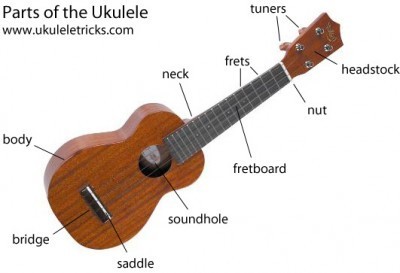
thanks to ukuleletricks.com for this great image
Who should you buy from? I recommend a uke-focused seller, because they will usually check and adjust the uke before they sell it to you. This is a good thing. I have personally dealt with and would recommend the online sellers Mim's Ukes and Uke Republic.
When in doubt, put your hands on the uke you want to buy and play it first. Does it feel good? Do you like the sound of it? That's what matters. That's what happened to me in the pic above. I had planned to JUST LOOK in the shop [stop laughing] and after a few strums, I was lost. I played a lot of ukes that day, most more expensive than this one, but this one felt just right in my hands and made sounds that made me happy.
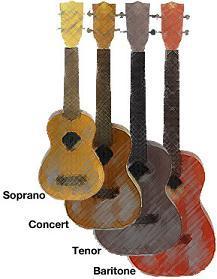
image via Lamorinda Music (thanks!)
What about all the sizes? How do you choose? This is easy: play them all. Ukes come [from smallest to largest] in Sopranino, Soprano, Concert, Tenor and Baritone sizes. Baritone uses the same tuning as a guitar and has a really deep sound, but still just 4 strings. The others use either GCEA tuning [my preferred] or ADF#B tuning, and sound like you imagine: the smaller ukes have higher-pitched voices. The most important point, in my opinion, is how the fretboard feels under your fingers. Some are made wide or thick, some are thin and flat, and every model feels different. The one that feels best to you is the right one. It's as personal a choice as the kind of knitting needle you like best.
Lamorinda Music has a great explanation of the different sizes of ukes here.
One more thing: there are tons of online ukulele resources to help you along on your journey. I've spent a lot of time at the Ukulele Underground forums, reading back posts and asking questions when a google wouldn't suffice. Lots of helpful people there. There are tons more places to explore. Google away!
Remember: ukes are happier in bunches. If you find you love the uke, teach someone else. Pass it on. Don't be shy.

May 25, 2011
WWW: Art & Science
Update on a story we told you about a while ago… Mary Scott Huff reports that two of her stolen sweaters were found at a Goodwill store in Portland, Oregon. They were totally unharmed, and a team of searchers is now combing other stores in the region.
[image error]
Knitting a labyrinth
Alberta fiber artist Linda Cunningham is knitting a fiber labyrinth during month long stay at Epcor Centre's Ledge Gallery in Calgary.The piece is intended to be one of the visual arts attractions of the Calgary International Children's Festival, with visitors encouraged to walk through the labyrinth. It will be on display until May 28th.
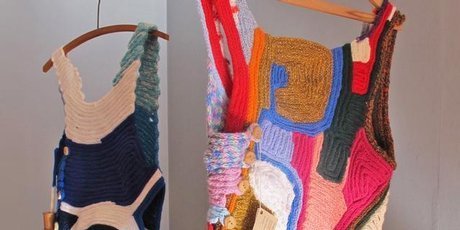
Fashion to think about
Anti-consumerist fashion designer Emma Churchill's new exhibition "French Knitting" at Lopdell House Gallery in Auckland, NZ, aims to challenge our approach to what we buy and encourage us to explore the production processes that go on to create those items we do buy.
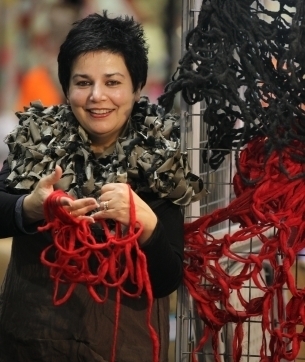
The artist
Australian fiber artist Teresa Dair appeared at the Craft and Quilt show in Perth, Australia this past weekend, demonstrating the art of "body knitting" – using her fingers and arms to replace the traditional needles in making garments.
She also replaces traditional materials with all sorts of "rough" materials, including steel wool and paper. Her garment and jewelry designs are fabulous – her site is definitely worth a visit.
On the topic of "body knitting", a group of first and second graders in Vermont are looking to break the Guinness World record for team finger knitting. The current record is held by a group of Austrian fourth-graders, for a strip of knitting 3.85 miles long. The Vermont students have a little more than four miles already, and will be working until June 8th, when the official measurement will be taken.
A nice piece on the Guardian newspaper blog about the use of craft to engage the public in science, highlighting the various coral reef projects, and the Stitch a Squid event at London's Natural History Museum last year.
Artist Ed Bing Lee has launched his "Delectable" collection – a series of knotted, beaded and woven desserts. Not knitted, but still stunningly beautiful!
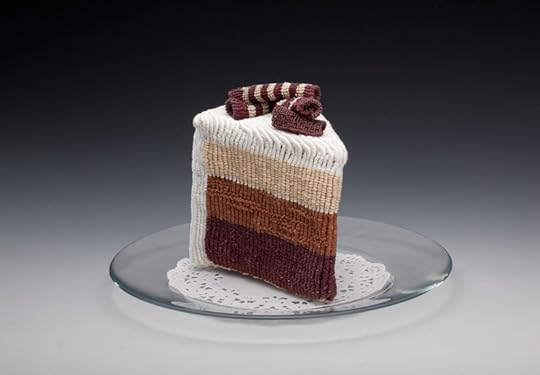
Yummy!

May 24, 2011
Spinning Tuesdays: Alpaca and Jacob
This week's spins in the great Must Spin spinathon are Alpaca and Jacob.
First up Huacaya Alpaca:
The Alpaca fiber I have is more dusty than dirty, and since Alpacas have no lanolin I opted for a quick warm soak in SOAK wash, and it worked fine.
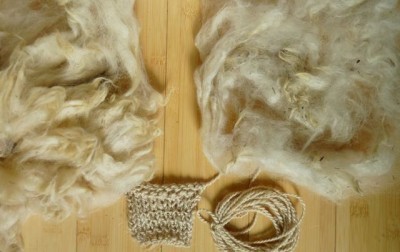
Alpaca - dirty and clean fleece, swatch and worsted 2 ply
The clean fiber had a fair amount of vm, but it's so silky that I was sure it would all fall out when I combed it. I was right. It was almost magic and I wish vm would fall out of wool that way!
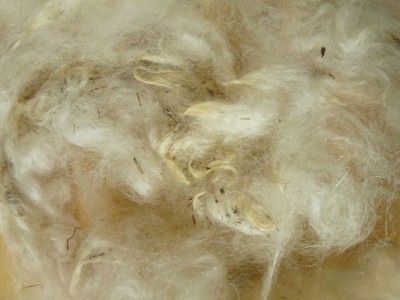
All of this vegetable matter just fell out when I combed the fiber - magic!
I have never processed Alpaca before and have never spun from anything but commercially processed top. I spun straight from the comb, worsted, with just a little more twist than I would normally use. My finished yarn is a little over twisted, but still drapey and soft.
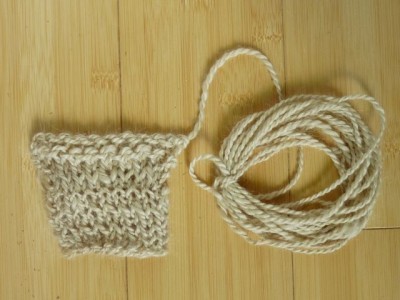
I need a little more practice for my Alpaca twist to be just right
Two fun facts about Alpaca from The Fleece and Fiber Sourcebook:
There are 22 natural shades of Alpaca
The staple length of a Huacaya is 2-6″, a Suri up to 11″
Next up Jacob.
I have raw Jacob and commercially processed Jacob, I liked both for different reasons.
I gave the raw Jacob, from the Spinning Loft, one round in hot water and Power Scour, leaving in some of the lanolin. Since the raw Jacob had only a little white mixed with the black I decided to card it all together and see what happened with both color and spinning. The white fiber seemed a bit shorter and springier, more like a Down breed, than the black.
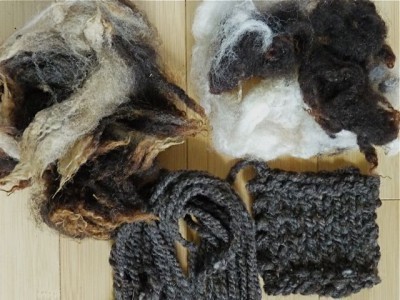
Jacob - dirty and clean fleece, 2 ply woolen yarn and swatch
I ran it through my drum carder 3 times and pulled it into roving. Then blissfully spun it long draw into a chunky 2 ply. My singles weren't exactly consistent, but it was easy to pick out any lumps that popped up.
The result is a soft (between Corriedale and BFL) and cushy yarn. I would wear it as a sweater. I love the blended color.
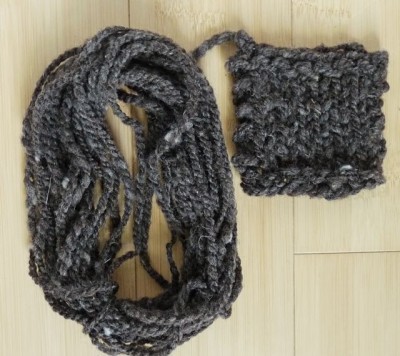
Cushy black yarn with a sprinkle of white
The commercial Jacob, from Spirit Trail Fiberworks, came in two wonderfully heathery colors, a dark brown and a white. I spun the brown into a 2 ply worsted and the white into a 2 ply woolen. I loved the consistency that I got from the commercial prep, no lumps or bumps, no vm. I didn't need to mind the spinning as much, so it went much faster. The only thing for me that I didn't care for was the lack of lanolin, the yarns still had the cush, but not the soft.
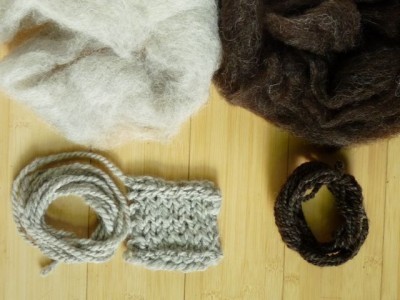
Lovely commercial Jacob roving - I love the tweedy colors
I will say that there are lots of times I will quickly give up the ability to control the lanolin for the convenience of being able to just sit and spin. For me it's about the spinning.
Two fun facts about Jacob from The Fleece and Fiber Sourcebook:
They can have between 2 and six horns
They are known for their multicolored fleeces
Stephanie Pearl-McPhee, the Yarn Harlot, spun and knit a beautiful shawl from a Lilac colored (gray) Jacob fleece. I love how she always finishes things. I wish I could borrow that ability from her.

May 18, 2011
WWW: Crochet Coral Reef Project, Knitting in the Movies, More Fiber Festival Goodness
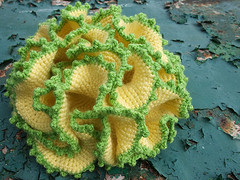
Image courtesy The Flame Lily.
The organizers of the Hawai'i Hyperbolic Crochet Coral Reef Project are seeking contributions. They're looking for sealife, both knitted and crochet. Perhaps a Flounder or two? Contact Michelle at HookTheReef at gmail dot com.
Photos of the contributions so far can be found on Flickr, and more info is available on Ravelry and in the Facebook group "Hook The Reef: Hawai'i Hyperbolic Crochet Coral Reef Project".
Toronto's Textile Museum announces their latest show, Magic Squares: The Patterned Imagination of Muslim Africa in Contemporary Culture. The exhibition features a selection of archaeological and historic artifacts from the Museum's collection of African textiles in which magic squares are present in their most evocative forms. Together with these artifacts, the show presents the work of four renowned contemporary artists: Jamelie Hassan, Hamid Kachmar, Alia Toor and Tim Whiten. Running May 18 to November 20, 2011.
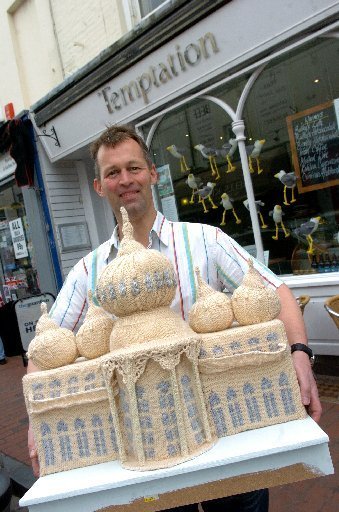
A landmark project.
The owner of a cafe in Brighton, UK, has spent 6 months knitting a replica of the landmark Royal Pavilion building. This is not his first such project – last year he knitted a model of the town's famous Palace Pier, and his shop is full of his own tea cosies.
A highlight of the Fremantle Heritage Festival, held May 27 to June 6th in Fremantle, Australia, is the Vintage Vixens and Vamps Fair. The Fair will feature 30 stalls of vintage and retro clothing, accessories, collectables and refashioning in the historic Fremantle Town Hall. This year, the Fair is hosting a sock knitting workshop "Our Foremothers' Traditional Techniques in Modern Designs".
Toronto's NOW Magazine features an interview with Kelly Reichardt, director of the movie "Meek's Cutoff". Knitting is a key activity in the film, so the director made an effort to find period-appropriate needles, and she tells a story about Michelle Williams' knitting escapades.
Did Amy's post about the Maryland Sheep & Wool Festival whet your appetite for some fleecy fun? Consider these other fiber festivals taking place all over the US in the near future… hopefully there's one near you.
Salomon Farm Park Fiber Arts Celebration!, Fort Wayne, IN, May 20-21.
Carolina Fiber Festival, Raleigh, NC, May 20-22.
Wool Fiber Arts Fair, Washington, IH, May 21.
Jamaica Fiber Festival, Jamaica Village, VT, May 21.
Rhode Island Wool and Fiber Festival, Bristol, RI,May 21.
Long Island Fleece and Fiber Fair, Riverhead, NY, May 21.
Spring Fiber Day, Romeo, MI, May 21.
Snake River Fiber Fair, Idaho Falls, ID, May 21 & 22.
Upper Valley Fiber Festival, Troy, OH, May 22 & 22.
Waynesburg Sheep and Fiber Festival, Waynesburg, PA, May 21 & 22.
Kentucky Sheep and Wool Festival, Lexington, KY, May 21 & 22.
8th Biennial Fiber Arts Fiesta, Albuquerque, NM, May 26-28.
Middle Tennessee Sheep, Wool and Fiber Festival, Dickson, TN, May 28-29.
Sacramento County Fair Wool Show, Sacramento, CA, May 26-30.
Massachusetts Sheep and Woolcraft Fair, Cummington, MA, May 28-29.
Great Lakes Fiber Show, Wooster, OH, May 28-29.
Pagosa Fiber Festival, Pagosa Springs, CO, May 28-29.
Eastern Angora Goat & Mohair Association Show and Sale, Frederick, MD, May 28-29.
Annual Shearing Festival and Craft Show, Springside Farm, Fabius NY, May 29-20.
The Maine Fiber Frolic, Windsor, ME, June 4-5th.
Flagstaff Wool Festival in Flagstaff, AZ, June 4-5th.
Estes Park Wool Market, Estes Park, CO, June 9-12.
Big Sky Fiber Arts Festival, Hamilton, MT, June 10-12.
A full list of Festivals and Events can be found on the Knitter's Review site.
And if you live in the Pacific Northwest and you like your yarn to come in skeins rather than sheep form, consider the Puget Sound LYS tour, being held this weekend.

Mandy Moore's Blog
- Mandy Moore's profile
- 6 followers


